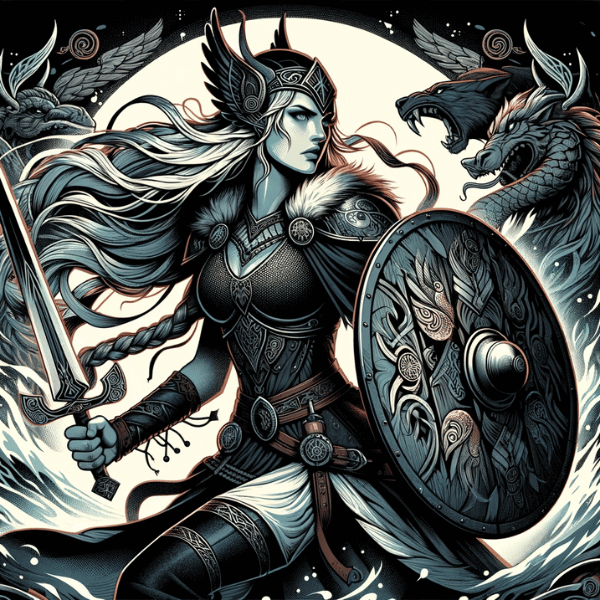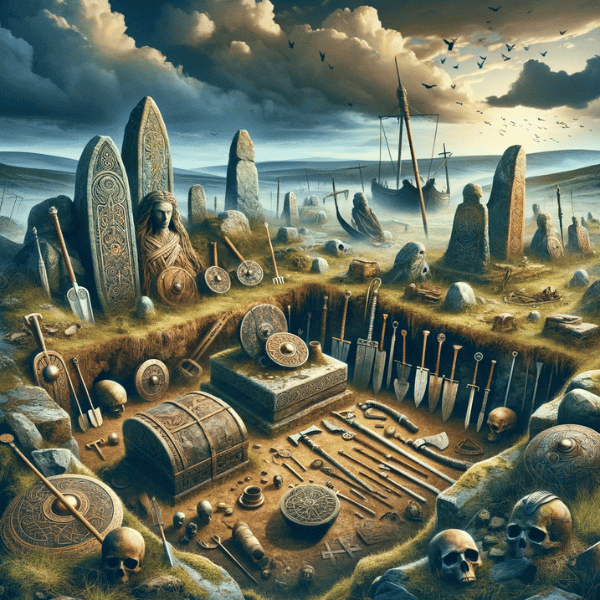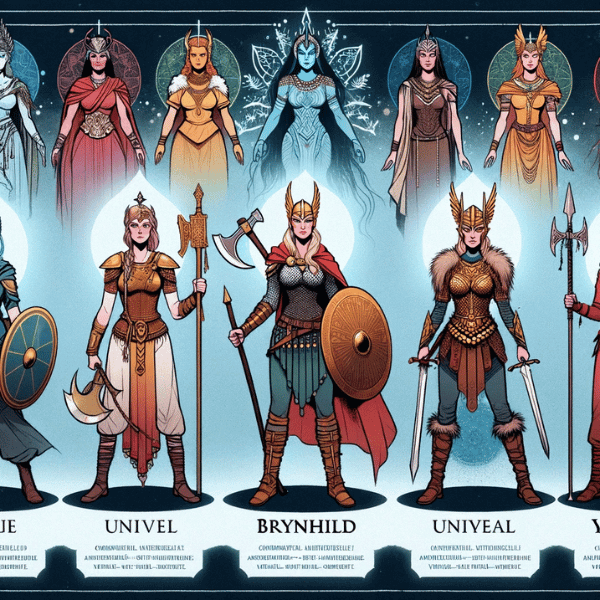Brynhild, a pivotal figure in Norse mythology, embodies a fascinating blend of strength, honor, and tragic destiny. As a revered shieldmaiden and a demigod, her story, deeply rooted in the ancient Nordic sagas, resonates through the ages. Brynhild’s saga, interwoven with themes of love, betrayal, and heroism, offers a captivating glimpse into the rich tapestry of Norse legends. Her character, often associated with formidable Valkyries, is not just a testament to the mythological lore of the Norse people but also reflects the complex interplay of fate and human agency in their storytelling. This introduction aims to unravel the layers of Brynhild’s narrative, highlighting her significance in Norse mythology and examining the roles she plays in the various epics where she appears. Her story is not just a mere myth; it’s a window into the cultural and spiritual ethos of the Norse world.
| Attribute | Brynhild Information |
|---|---|
| Origin | Norse Mythology |
| Character Type | Legendary Valkyrie and Heroine |
| Role | Valkyrie and legendary heroine known for her bravery |
| Ring of Fire | Imprisoned in a ring of fire as a punishment for disobedience |
| Love Story | Famed for her tragic love story with Sigurd (Siegfried) |
| Cultural Impact | A central character in Norse and Germanic sagas, symbolizing love and tragedy |
| Depictions | Featured in the Völsunga Saga and the Nibelungenlied, among other sagas and poems |
1. The Origin and Mythology of Brynhild
Mythological Background
Brynhild, often hailed as a formidable figure in Norse mythology, emerges from a lineage intertwined with the divine and the mystical. Her origins, steeped in ancient lore, position her as a demigod, blending the realms of mortal and divine. As a shieldmaiden, she transcends mere mortal status, embodying the valor and strength revered in Norse culture. Her connections to other gods, particularly in her roles and interactions, reveal a complex network of relationships that define the intricate hierarchy of Norse deities. This exploration into Brynhild’s lineage not only illuminates her place within the Norse pantheon but also underscores the nuanced interplay between gods and heroes in these ancient tales.

Brynhild in the Eddas
The Eddas, primarily the Poetic Edda and the Prose Edda, serve as crucial sources for understanding Brynhild’s narrative. In these texts, her character is portrayed with a depth that spans a spectrum of emotions and roles. From a warrior of unparalleled prowess to a figure central to tales of love and retribution, the Eddas paint a comprehensive picture of her persona. Translations and interpretations from esteemed scholars offer varied perspectives on her story, each adding layers to our understanding of her character. These interpretations not only bring to life the saga of Brynhild but also offer insights into the broader context of Norse mythology, where each character and story interlocks to form a rich, cultural tapestry.
2. Brynhild’s Role in Norse Myths
Brynhild in the Volsunga Saga
In the Volsunga Saga, one of the most revered epics in Norse literature, Brynhild emerges as a character of profound complexity and pivotal importance. Her role transcends that of a mere warrior; she is a central figure whose actions and decisions propel the narrative forward. The saga chronicles her evolution from a fearless shieldmaiden to a character engulfed in the throes of love, betrayal, and vengeance. Her decisions, often driven by a strong sense of honor and justice, highlight the moral and ethical frameworks of Norse society. An analysis of these decisions reveals a character who is not only powerful in combat but also deeply human, grappling with emotions and dilemmas that resonate across time and culture.
Relationships with Other Characters
Brynhild’s interactions and relationships, particularly with the hero Sigurd, form the crux of many narratives within Norse mythology. Her relationship with Sigurd, marked by love, betrayal, and ultimately tragedy, is emblematic of the themes that pervade Norse legends. Their story is not just a tale of romance but a complex interplay of fate, choices, and consequences. The dynamics of their relationship encapsulate the Norse understanding of love as a powerful, often uncontrollable force that can lead to both greatness and ruin. Additionally, Brynhild’s interactions with other characters provide a multifaceted view of her persona, showcasing her as a figure of respect, fear, and intrigue in the mythical world.

3. Symbolism and Cultural Significance
Symbolism of Brynhild
Brynhild, in Norse mythology, is not just a character but a symbol embodying various facets of Norse culture. She represents the quintessential Norse values of honor and bravery, often depicted as a paragon of the warrior spirit. Her story also delves into the darker themes of vengeance and retribution, reflecting the complex moral codes and the often harsh realities of Norse life. Brynhild’s journey from a warrior to a figure enmeshed in tragic love and vengeance serves as a canvas to explore the consequences of honor-bound decisions and the inexorable pull of fate. Her character becomes a conduit through which the sagas communicate the intricate balance between personal honor and the overarching destiny that governs the Norse mythological world.

Brynhild in Modern Culture
The impact of Brynhild’s character extends far beyond the ancient texts; she has become a significant influence in modern culture. Her portrayal in literature, art, and media often reflects the enduring fascination with Norse mythology. In literature, Brynhild has inspired characters in fantasy novels and plays, often serving as a prototype for strong, complex female warriors. In art, her story has been captured in numerous forms, from classical paintings to modern digital illustrations, each interpretation offering a unique perspective on her saga. Additionally, in media, elements of her story and character traits can be seen influencing various works, ranging from operas to contemporary films and video games. This continued relevance and adaptation underscore her timeless appeal and the universal themes she represents.
4. Historical Perspectives and Interpretations
Historical and Archaeological Evidence
The legend of Brynhild, while deeply rooted in mythology, intersects intriguingly with historical and archaeological findings. Evidence from various Norse archaeological sites, including burial mounds and artifacts, provides a tangible connection to the world in which these myths were conceived. For instance, the discovery of graves of warrior women, some even with remnants of weapons and horses, offers a real-world parallel to the mythical shieldmaidens like Brynhild. Historians and archaeologists often interpret these findings as indicators of the roles and statuses women could hold in Norse society, lending credence to the tales of female warriors. These findings not only enrich our understanding of Norse mythology but also offer a glimpse into the daily lives, beliefs, and societal structures of the Norse people.

Scholarly Interpretations
The interpretation of Brynhild’s legend is a subject of extensive scholarly debate, with various experts offering differing perspectives. Norse mythology scholars dissect her story to understand its underlying themes, its historical context, and its place in the broader Norse cosmology. Some view her as a symbol of resistance against patriarchal norms, while others interpret her tale as a representation of tragic love and its consequences. Additionally, the comparison of her story to other mythological and heroic narratives across cultures provides a broader understanding of her archetype. This diversity of academic perspectives not only enriches the discourse around Brynhild but also highlights the multifaceted nature of mythological interpretation.
5. Comparative Mythology
Brynhild in Comparative Context
Exploring Brynhild’s story within the broader scope of comparative mythology offers insightful parallels and contrasts with similar figures in other mythological traditions. Her character shares attributes with other legendary female figures across various cultures, such as the Greek Amazon warriors or the Celtic queen Boudica, who embody strength, leadership, and defiance. These comparisons highlight a recurring archetype of the female warrior, prevalent in many ancient societies. Moreover, the themes of tragic love, honor, and vengeance in her saga find echoes in other myths, like the tragic love story of Tristan and Isolde in Arthurian legend or the themes of honor and retribution in the Epic of Gilgamesh. Such comparisons not only underscore the universality of these themes across human cultures but also illustrate how different societies have narratively explored similar human experiences and dilemmas.

6. Conclusion
Brynhild, a multifaceted figure in Norse mythology, stands as a testament to the rich narrative tradition of the Norse people. Her saga, intertwining themes of honor, love, and vengeance, reveals much about the values and beliefs of ancient Norse society. From her origins as a demigod to her portrayal in the Eddas, and her continued influence in modern culture, Brynhild’s story resonates with timeless relevance. Her character, echoing through historical findings and comparative mythology, highlights the universal appeal of such mythological figures. Brynhild’s legacy, thus, transcends the confines of Norse mythology, embodying the enduring human fascination with heroes, heroines, and the intricate tales that weave their fates. In her, we find a powerful symbol of strength, complexity, and the enduring impact of myth on human understanding across ages.
